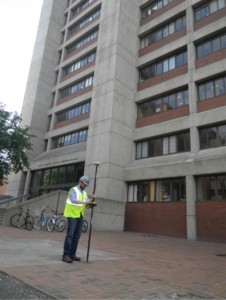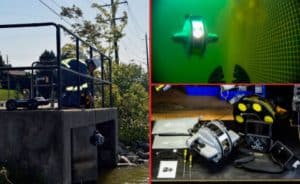The Geo 7X Tackles Tough Jobs with Style and Grace
One common aspect of field data collection is that it often happens in remote places with no cell coverage or worse yet no Starbucks. Running low on caffeine can seem tragic at times but a GNSS handheld that runs low on satellites is certain doom for those jobs we consider tough. Simply put, in the field you just want equipment to be reliable and work right. At the end of the day you want to leave the field with a smile knowing you picked the right equipment for the job.
In many cases GNSS data is collected with a poor view of the sky. We stand under trees, next to tall buildings, in alleyways, and along streams in deep canyons. For field applications where positional accuracy is not important, this is generally not a big issue. However, in cases where both productivity and accuracy are critical, special equipment is required to collect quality GIS data and avoid poor results.
Collecting quality GNSS data in tough environments is important to a wide range of professionals. It’s the stormwater mapping technician in an urban setting where high accuracy vertical data is important to flow analysis or the forester walking the perimeter of a timber stand for an accurate acreage. At a university, it’s the planner who needs high resolution topographic data for site selection and construction planning.
I recently asked Don Hulst, the Director of Campus Mapping, GIS & Space Management at Washington State University, about the Trimble Geo 7X handheld and the importance of high accuracy GNSS data. This is what he had to say….
“We have incorporated the new Geo 7X CM Edition into our campus infrastructure GIS data collection projects with great success. The Geo’s user friendly interface, along with the high accuracy GNSS has brought greater precision to our campus maps and simplified our GIS data workflow”.

The ability to collect spatially accurate data in adverse GNSS conditions has progressed considerably in the past few years. The Geo 7X, for example, is in the 1 – 2 meter range under moderate canopy. For comparison, the Trimble Geo of five years ago was 5 meters or more in the same environment. Further, a fast cold start under heavy canopy or in places with similar obstructions is more feasible today. This wasn’t always the case where focusing on positional accuracy often meant an inability to acquire satellites in difficult places.
For those of you who rely on SBAS as a free source of real-time correction, you want a device like the Geo 7X which uses both GPS and GLONASS satellites to compute a corrected position. This is a significant improvement over devices that only use GPS with SBAS.
It seems appropriate that a tough job includes features that are difficult or dangerous to reach. In such cases, the right equipment for the job includes a built in laser rangefinder for offset mapping. With the 7X and optional laser module, stand in a favorable GNSS location and map the face of a cliff, rattlesnake cave entrance, or sleeping grizzly bear with ease.
Finding a challenging environment for GNSS data collection is easy. Remember to bring the right tools for the job so you can return to the office with quality data and a smile.
For more information on the right equipment for tough jobs, contact us.








